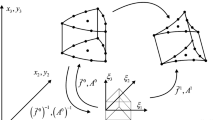Abstract
This paper presents a novel formulation of the completed indirect boundary-element method to study the shrinkage of air bubbles on a slow viscous flow in a bounded region subject to surface tension. The formulation has application to viscous sintering, a process for manufacturing high-quality glass by means of sol-gel processing. The theoretical background is explained in detail, including mathematical proofs of existence and uniqueness of solutions. Numerical results are included and compared to analytical and previous numerical solutions.
Similar content being viewed by others
References
H. K. Kuiken, Viscous sintering: the surface-tension-driven flow of a liquid form under the influence of curvature gradients at its surface. J. Fluid Mech. 214 (1990) 503-515.
H. K. Kuiken, Deforming surfaces and viscous sintering. In: D. G. Dritschel and R. J. Perkins (eds), The Mathematics of Deforming Surfaces. Oxford: Clarendon Press (1996) 75-97.
G. A. L. van de Vorst, R. M. M. Mattheij and H. K. Kuiken, A boundary element solution for two-dimensional viscous sintering. J. Comp. Phys. 100 (1992) 50-63.
G. A. L. van de Vorst and R. M. M. Mattheij, Numerical analysis of a two-dimensional viscous sintering problem with non-smooth boundaries. Computing 49 (1992) 239-263.
H. A. Lorentz, A general theorem on the motion of a fluid with friction and a few results derived from it (in Dutch). Versl. Acad. Wetensch 5 (1896) 168-175. Translated and reprinted by H. K. Kuiken, J. Eng. Math. 30 (1996) 19-24.
H. Power and G. Miranda, Second kind integral equation formulation of Stokes flows past a particle of arbitrary shape. SIAM J. Appl. Math. 47 (1987) 689-698.
H. Power, Second kind integral equation solution of Stokes flows past n bodies of arbitrary shape. In: C. A. Brebbia, W. L. Wendland and G. Kuhn (eds), Boundary Elements IX, Vol. 3. Berlin: Springer-Verlag (1987) 477-488.
S. J. Karrila, Y. O. Fuentes and S. Kim, Parallel computational strategies for hydrodynamic interactions between rigid particles of arbitrary shape in a viscous fluid. J. Rheology 33 (1989) 913-947.
H. Power and G. Miranda, Integral equation formulation for the creeping flow of an incompressible viscous fluid between two arbitrary closed surfaces, and a possible mathematical model for the brain fluid dynamics. J. Math. Anal. Appl. 137 (1989) 1-16.
S. J. Karrila and S. Kim, Integral equations of the second kind for Stokes flow: direct solution for physical variables and removal of inherent accuracy limitations. Chem. Eng. Commun. 82 (1989) 123-161.
H. Power, Matched-asymptotic analysis of low Reynolds number flow past a cylinder of arbitrary cross-sectional shape. Math. Appl. Comp. 9 (1990) 111-122.
H. Power, The low Reynolds number deformation of a gas bubble in shear flow: a general approach via integral equations. Eng. Anal. with Boundary Elements 16 (1992) 61-74.
H. Power, The completed double layer boundary integral equation method for two-dimensional Stokes flow. IMA J. Appl. Math. 51 (1993) 123-145.
S. G. Mikhlin, Integral Equations and their Application to Certain Problems in Mechanics, Mathematical Physics and Technology. London: Pergamon Press (1957) 338pp.
S. Kim and S. J. Karrila, Microhydrodynamics: Principles and Selected Applications. London: Butterworth-Heinemann (1991) 507pp.
C. Pozrikidis, Boundry Integral and Singularity Methods for Linearized Viscous Flow. Cambridge: Cambridge University Press (1992) 259pp.
H. Power and L. C. Wrobel, Boundary Integral Methods in Fluid Mechanics. Southampton: Computational Mechanics Publications (1995) 330pp.
O. A. Ladyzhenskaya, The Mathematical Theory of Viscous Incompressible Flow. New York: Gordon and Breach (1963) 185pp.
R. Courant and D. Hilbert, Methods of Mathematical Physics. London: Interscience (1992) Vol. 2, 830pp.
F. Hartmann, Introduction to Boundary Elements. Berlin: Springer-Verlag (1989) 416pp.
C. A. Brebbia, J. C. F. Telles and L. C. Wrobel, Boundary Element Techniques. Berlin: Springer-Verlag (1984) 464pp.
G. A. L. van de Vorst, Integral method for a two-dimensional Stokes flow with shrinking holes applied to viscous sintering. J. Fluid Mech. 257 (1993) 667-689.
A. R. M. Primo, Novel Boundary Integral Formulations for Slow Viscous Flow with Moving Boundaries, Ph.D. Thesis, Brunel University, UK (1998) 169pp.
J. E. Gómez and H. Power, A multipole direct and indirect BEM for two-dimensional cavity flow at low Reynolds number. Eng. Anal. with Boundary Elements 19 (1997) 17-31.
I. D. Chang and R. Finn, On the solution of a class of equations occurring in continuum mechanics, with application to the Stokes paradox. Arch. Rational Mech. Anal. 7 (1961) 388-401.
C. Pozrikidis, The instability of a moving viscous drop. J. Fluid Mech. 210 (1989) 1-21.
E. Goursat, A Course in Mathematical Analysis. New York: Dover Publications (1964) Vol. II, 389pp.
Author information
Authors and Affiliations
Rights and permissions
About this article
Cite this article
Primo, A., Wrobel, L. & Power, H. An indirect boundary-element method for slow viscous flow in a bounded region containing air bubbles. Journal of Engineering Mathematics 37, 305–326 (2000). https://doi.org/10.1023/A:1004631329906
Issue Date:
DOI: https://doi.org/10.1023/A:1004631329906




